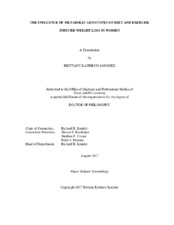| dc.description.abstract | The purpose of this study was to retrospectively determine the influence of genetic profiling on diet type and exercise for weight loss, body composition, and biomarkers of metabolic health in previously sedentary women. SNPs in obesity candidate genes ADRB2-79, ADRB2-46, PPARγ2, FABP2, and ADRB3 were evaluated to predict health outcomes. Eighty-six women (age 37.5±13.4 yrs; ht 163.7±6.9 cm; wt 82.0±16.8 kg; 40.8±5.1% body fat) were randomized to the control (CTRL), American Heart Association (AHA), Curves Complete-I (CC-I), or Curves Complete-II (CC-II) program for 24-wks (N=86). Participants in the diet groups followed a 1,400 kcal/d diet for 1 wk; 1,500 kcal/d diet for 23 wks (AHA 55%:15% CHO:PRO, CC-I 25%:45% CHO:PRO, CC-II 15%:45% CHO:PRO), while participating in supervised resistance circuit (3x/wk) and Zumba exercise (1x/wk). Remaining subjects in the CTRL had no diet or exercise intervention. Body composition, anthropometrics, resting energy expenditure (REE), physical activity, and psychosocial assessments were measured at 0, 4, 8, 12, 16, 20 and 24 weeks. VO₂max capacity, upper and lower body isotonic strength and endurance, and lipid biomarkers were assessed at 0, 12, and 24 weeks. Data were analyzed using multivariate analysis of variance for repeated measures. MANOVA of body composition data revealed time x diet interaction (Wilks’ Lambda p=0.05) with no difference observed among diet groups (p=0.86), as all diet groups significantly improved these variables and CTRL had no deviation from baseline after 24 wks. MANOVA of body composition (body weight, fat mass, lean mass, fat-free mass, and body fat %) revealed an overall time effect (Wilks’ Lambda p<0.001), but no time x match interaction (p=0.99) when analyzed as a genetically True (T) or False (F) match to diet. Both T and F participants matched to diet revealed similar weight loss (F -4.25±0.93; T -4.63±0.85 kg, p=0.61). Results indicate that women following a controlled diet and exercise program experience similarly favorable changes in body composition, cardiovascular fitness, and biomarkers of health. However, diets designed for weight loss based on SNP profiles elicits further research, as no time x genetic match interactions in body weight or composition were observed in T and F matches to diets. | en |


